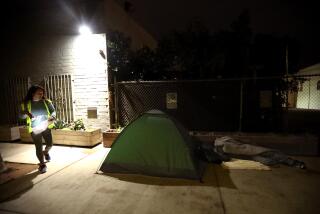Opinion: What you really see when you step outside to count homeless people in Los Angeles
In the dark of Holly Park, the three of us walk around the baseball field, winding our way past the arc of concrete bleachers, flashlights in hand, scanning the landscape for homeless people who may have bedded down for the night. We are volunteers on Night 2 of the homeless count in Los Angeles County. On the path that stretches ahead of us, we see a figure moving. We stop. Itās a coyote. The animal lopes into the darkness and out of sight.
Counting homeless people for the annual point-in-time tally that takes place over three nights this week is as much about seeing whatās there as it is about seeing whatās not there.
Iāve now done this count four years in a row, examining five different locations over that time. (The first year, I energetically went to two locations on back-to-back nights. Thatās unlikely to happen again.) East L.A., Brentwood, Van Nuys, Mar Vista ā and this year, Iāve wound up in the South Bay city of Hawthorne.
One of the people on the team of volunteers Iām out with is a 27-year-old woman studying to be an urban planner. She grew up here and has watched the arrival of Elon Muskās SpaceX company begin to transform her hometown of working- and middle-class residents into a buzzy city. The other person on the team is an 18-year-old woman who lives in the southernmost stretch of the South Bay, in Palos Verdes Estates. For all of us, this is part civic duty, part simply seeing homelessness close-up. And whether you see any homeless people, you canāt walk across the grass of a desolate park on a January night without feeling for just a few minutes the vulnerability and ragged cold that unsheltered people cope with all night long.
As we go back toward the car, we see something move in the parking lot. A skunk. The animal skitters past the car and under a Dumpster. We wait for it to leave.
We drive past a golf course (thereās no counting of the homeless on private property) and an elementary school and through residential neighborhoods. We park near a freeway overpass and get out of the car, shining our flashlights through wire fencing onto steep, grassy slopes that head down to the freeway. No one. We are heading north on Western Avenue when we pass a bus stop. Someone spots a stroller, and we slow down. The stroller is piled with tattered items and sits beside bulky piles of belongings. We canāt park. We drive on and come back to take a closer look. Is there a human embedded in all that stuff? We make a decision to mark it simply as a makeshift shelter.
Finally, at a busy intersection, we see a young man, alone, crossing the street, with two bags. Homeless? āHe was wearing some nice Vans,ā the 18-year-old observed. And he was walking purposefully. We decide heās not homeless.
In the end, we saw more furry critters than we did unsheltered homeless people. That doesnāt mean there are no homeless people in Hawthorne (last year, 185 were counted in the city) or even suggest that the problem has dramatically improved. It just means we werenāt assigned the census tract that included the parking lots of 24-hour drugstores and gyms and other relatively safe areas that often draw the homeless. And even a tally of one or none adds to the data about where homeless people are in the county.
But, as Iāve said before, I always worry that Iām missing someone. Maybe as I was gabbing about being left-handed, I looked away from a row of bushes and missed someone. Being in a team of three or four helps. Thereās always a set of back-up eyes scanning the sidewalks. But even 7,000-some volunteers wonāt see every unsheltered homeless person in Los Angeles County ā or will mistakenly count one as two.
Itās a requirement for federal funding that every jurisdiction in the nation do a homeless count. Because the same method for counting is used every year, the count has been a reliable tool to gauge year-over-year changes in the homeless population, according to the Los Angeles Homeless Services Authority.
I like that the count draws so many people out of their houses and onto the streets and sidewalks to see how homeless people live. That certainly has to be one of the countās public services too.
More to Read
A cure for the common opinion
Get thought-provoking perspectives with our weekly newsletter.
You may occasionally receive promotional content from the Los Angeles Times.











